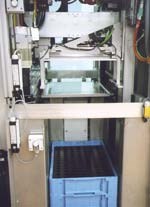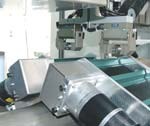Meet The Multi-Center
How shops use the multi-spindle machine tool is changing. Complex workpieces, shorter production runs, rapid change-over and single part handling reflect the new reality of multi-spindle production. Builders are responding to these changing needs with new ways to make the multi-spindle machine more profitable, useful and efficient.
It’s Saturday morning at the EMO show in Hanover, Germany. I arrive at the Tornos Technologies booth for my 10 a.m. meeting with Tom Broe, multi-spindle product manager for the company’s U.S. operation (Brookfield, Connecticut). It’s one of the few moments that the booth is not packed with show attendees who, like me, are looking to see what’s new from Moutier, Switzerland’s premier machine tool builder.
For this visit, I’m interested in multi-spindles. My hope for the meeting is to follow up on a visit to Moutier earlier in the year when the MultiDeco 32/6c was introduced at a technical conference. The machine incorporates some interesting technological innovations that the newest multi-spindle, the MultiDeco 20/8d being debuted at EMO, takes even further. Both of these machines reflect multi-spindle trends that are bent on solving production problems in today’s precision machined parts industry.
Tom and I each grab a cup of coffee and settle down to discuss the “whats” and “whys” of these new machine tool developments.
Reality
In the United States, most of the free-machining work that was the traditional foundation of multi-spindle manufacturing has been dislodged in favor of lower cost producers (most are located in Asia). Much of the work left can best be described as “fussy,” meaning it is made from more difficult-to-machine material with complex geometries, requiring tighter tolerances, to a higher quality standard, in smaller lot sizes and often with no nicks or scratches permitted on the part surface.
It is the need for shops to profitably produce this kind of work that is driving machine tool builders, like Tornos, to develop multi-spindle technologies that will help precision turned parts makers compete in the multi-spindle market. Reduction of direct manufacturing costs is the key to the success of the modern metalworking shop, but it’s more complex than simply reducing direct labor.
Tom recounts to me the traditional role of the machinist running a multi-spindle. After setup and production of a successful first article, the job run required the machinist to load material, handle chips, handle parts, gage the parts and keep track of the cutting tools. Because these tasks are all manual and often mundane, it’s increasingly difficult to find people to perform them.
“Many people think the goal of our new CNC multi-spindles’ automation is to eliminate labor,” Tom says. “That’s a misnomer. While less attended operation may be a goal, the reality is to try to make better, higher value-added use of the labor in a shop. That’s where the automation on these machines comes in. It frees the machinist from the traditional manual operations needed to run multi-spindles to perform higher value tasks. That’s an important potential competitive advantage.”
Integral Material Handling
Increasingly, visual appearance requirements are included as part of the specification for many precision machined parts. Because of this, simple gravity is not sufficient to evacuate finished parts from the machining zone.
On the new Tornos multi-spindles, an integral gantry manipulator is part of the package (one on the 32/6c and a single or double unit on the 20/8d). As is often the case, customers came up with the idea of internal part manipulation because of cosmetic specs.
“Several of our customers had installed their own manipulators to keep critical parts from getting banged up tumbling down an exit chute,” Tom says. “That caused us to include a manipulator in the design of our MultiDeco 32/6c and the 20/8d as well.”
While controlled extraction of finished parts was the initial motive behind the manipulator, many additional options opened up once it became part of the design. It could allow the machine to be operated as a bar fed machine with the gantry unloading finished parts or as a chucker with the gantry loading blanks and unloading finished parts.
The gantry is a programmable axis controlled by the CNC. Setup for a specific job requires only defining the gantry travel parameters and attaching the proper grippers. The gantry speed is programmable to synchronize with the machine’s cycle time.
Palletizing
Another customer-driven innovation that Tornos has incorporated into the design of its new multi-spindles is the ability to palletize incoming and outgoing workpieces. “Once the gantry load/unload manipulator is in place, we have control of where the workpieces enter the cycle and exit the cycle,” Tom explains.
Both of the new machines have space built into the machine platform to accommodate various kinds of pallet systems. The company offers one of its own design as an option, but many shops may opt to design and build their own systems. Because the palletization area is inside the machine footprint, no additional floor space is needed.
With the finished parts organized into the pallet, material handling for subsequent operations can be eliminated. Pallets can be designed to carry finished parts to heat treat or clean without the need to handle them individually.
Automated Gaging And Machine Compensation
Another benefit derived from the ability to control work handling inside the machine is the ability to pass a part that was removed from the final operation through a gage. Laser gages are especially suited for this kind of checking.
A gage can be set up to perform a simple go/no-go measurement, or it can check a critical dimension as the part passes through it on the way to the pallet. “An advantage of this automated inspection compared to traditional post-process checking is that if a part has run out of tolerance, only a few parts are made subsequently,” Tom explains. “The gage can be set to stop the operation, and whatever fix is needed can be performed before many bad parts are produced.”
Taking the integral gage setup a step further, it can be used with the machine’s CNC as a closed-loop system that will automatically perform tool compensation based on measurement trends. The gage is set with a tolerance band width, and as tools wear or temperatures change, the gage can comp the tool slides as necessary to keep the parts within the tolerance band. “No more need to bring out the large, medium or small hammer to comp tools,” Tom jokes.
Independent Spindle Speeds
Traditionally the multi-spindle main drive is a spindle motor geared to rotate all spindles at once. The trend in multi-spindles is to motorize each spindle independently to optimize speeds and feeds for each station. “Much of the issue about controlling chip formation is simplified when the optimum cutting speed and feed is used on a given station,” Tom says. “Moreover, these integral spindles are bi-directional, allowing the option of left-handed or right-handed machining.”
The MultiDeco 20/8d is Tornos’ first integral spindle machine. Each of the machine’s eight spindles is powered by an integral 11.2-Kw (15-hp) motor. The motors are programmable through the machine’s CNC and can rotate from 0 through 8,000 rpm. Contouring in the C axis can also be programmed on any one of these spindle motors. For stationary operation, a stop in the position of one-tenth of a degree is available. An electric brake holds the spindle in position. According to Tom, the MulitDeco 32/6c is slated to get its integral motor spindle drum next.
From a design and engineering perspective, independent spindles on a multi-spindle bring up production issues for the shop. One issue is the need to rewind the drum at the end of a cycle.
For reliable operation, each spindle motor is hard wired. This requires that the spindle drum “rewind” after a full rotation. A dedicated motor is used by Tornos to accomplish this rewind in the least amount of time.
Thermal stability is another issue that can be problematic with the addition of integral motors to the multi-spindle drum. Each motor is a source of heat, and with six or eight motors, an active system to help thermally stabilize the machine is necessary.
To maintain temperature stability, a jacket surrounds the bearings for each spindle. Chilled cooling oil is circulated around the spindle bearings and this heat dissipation system maintains the thermal stability of the spindle bearings—including the integral motors, which are attached to the spindles. The chiller unit is capable of holding a programmed temperature at ± 0.5 degree centigrade.
Three-Axis Backworking
The ability to complete a workpiece in a single handling is not only important to precision machined parts manufacturing, but is necessary to compete. Complex parts are not only machined on one side. Backworking capability is needed to eliminate secondary operations and accomplish the task of complete machining within the multi-spindle.
On the 20/8d, the company uses one or two, two-axis counterspindles for backworking operations and a single-axis backworking slide for three-axis flexibility. Each of these spindles is independently programmable and brings flexible processing options to backworking.
“On the ‘eight spindle,’ two pickoff spindles allow us to divide the backworking operations, done simultaneously with the main spindle, by two to reduce cycle time,” Tom explains. “Often, backworking is the longest operation, so using two counterspindles helps balance the cycle. We can also set the machine to run as two ‘four spindles’ using each counterspindle independently for double-drop production. It’s about flexibility and production choices. Most importantly, it’s about the capability to process parts complete.”
In operation, the counterspindle grips a cutoff part and then executes drilling, milling and turning operations using up to five tools mounted vertically or horizontally. The operation slide can also use driven tools and is equipped with through-the-tool coolant delivery.
A Multi-Center
As manufacturing deals with the changes being imposed by competition, throughput, flexibility and consistent quality are the metrics by which work is being awarded. Consolidation of operations has been ongoing in metalworking for years, which is evident by looking at the machining center and turning center.
As builders of multi-spindles apply the same concepts to precision turned parts, the beneficiaries are the shops that need a technological edge to compete for the business that’s available. Metalworking must continue to move in the direction of automating part handling, chip removal, tool monitoring, part inspection and other processes.
Related Content
Laser Technology "Turns" into a Turning Tool
This new technology uses a laser to act as a cutting tool to "turn" parts from solid barstock. This high-speed precision turning machine is especially useful for micromachining, enabling high accuracy for small, complex parts that are often delicate and difficult to machine when implementing conventional turning processes.
Read MoreDoes a Scanning Probe Make Sense on a Swiss-Type?
Swiss-types have limited tooling capacity, but there can be advantages to giving up some of that capacity to take advantage of a touch probe — in fact, a scanning probe — to enable in-process part measurements.
Read MoreKeeping Watch on Small Parts
From watch parts to exotic medical applications, this shop takes on the world of micromachining.
Read More6 Tips for Training on a Swiss-Type Lathe
There are nuances to training a person to effectively operate a Swiss-type lathe. A shop I visited a while back offers some suggestions.
Read MoreRead Next
Rethinking The Multi-Spindle
When the Index MS line, with its open front-end design, hit the streets 4 years ago, it was obviously different. The question is why is it so different? The answer is revealing.
Read MoreSeeing A Multi Through Different Eyes
Sometimes if you don’t 'know' any better, applying technology in new ways simply makes sense. That’s partly what helped drive this family-owned OEM to acquire its first, and so far only, multi-spindle to help it get a better handle on production and inventory control.
Read More5 Aspects of PMTS I Appreciate
The three-day edition of the 2025 Precision Machining Technology Show kicks off at the start of April. I’ll be there, and here are some reasons why.
Read More


.jpg;maxWidth=150;quality=70)










.jpg;maxWidth=300;quality=90)










.jpg;maxWidth=400;quality=70)

